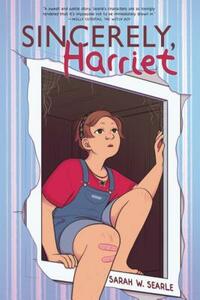Take a photo of a barcode or cover
Sincerely, Harriet is the sort of book I would have loved to read as a teen. The story follows Harriet Flores, a thirteen year old white Latinx girl who begins the book by writing postcards to her friends at camp. She isn't at camp, for reasons that become clear as the story progresses. Instead, she's essentially trapped in the two-family home her family shares with an older Black woman, who lives on the first floor. Harriet's journey is subtle but nuanced, and I adored this book. (Even though it made me cry.)
Some of what follows is a bit spoilery, so if you wish to avoid spoilers, please head off to read it now and don't finish this review.
Harriet lives mostly in her head. She struggles to complete her summer reading because she doesn't see herself in the books she's been assigned, like The Great Gatsby. We eventually learn that she's been home-schooled for the last two years and that she's entering public school in just a few weeks. It's a time of pre-transition, that anxious, but boring inbetween. Searle captures it beautifully with her soft and emotional style.
Harriet's loneliness is a character in this book. She has largely fictionalized her relationships with the girls to whom she's writing. She has a crush on one of them, and considers the other a friend. (This is not the case, as we learn later in a heartbreaking scene.) Her parents are gone all day and into the night, working. And she hears strange sounds from the empty floor above the apartment.
The story that unfolds is one of invisible disabilities, generational healing, and friendship in unexpected places. It's one of loneliness and comfort, of abandonment and family. It's about a queer, disabled girl figuring out who she is and how her relationships can harm or heal her. She hurts and hurts others, but she learns and grows, gives and receives love. It's absolutely lovely.
I received a digital copy of this book for review purposes via NetGalley.
Some of what follows is a bit spoilery, so if you wish to avoid spoilers, please head off to read it now and don't finish this review.
Harriet lives mostly in her head. She struggles to complete her summer reading because she doesn't see herself in the books she's been assigned, like The Great Gatsby. We eventually learn that she's been home-schooled for the last two years and that she's entering public school in just a few weeks. It's a time of pre-transition, that anxious, but boring inbetween. Searle captures it beautifully with her soft and emotional style.
Harriet's loneliness is a character in this book. She has largely fictionalized her relationships with the girls to whom she's writing. She has a crush on one of them, and considers the other a friend. (This is not the case, as we learn later in a heartbreaking scene.) Her parents are gone all day and into the night, working. And she hears strange sounds from the empty floor above the apartment.
The story that unfolds is one of invisible disabilities, generational healing, and friendship in unexpected places. It's one of loneliness and comfort, of abandonment and family. It's about a queer, disabled girl figuring out who she is and how her relationships can harm or heal her. She hurts and hurts others, but she learns and grows, gives and receives love. It's absolutely lovely.
I received a digital copy of this book for review purposes via NetGalley.
While I have not suffered the challenges of chronic illness, I've spoken to others who have... and isolation is one of the worst parts of this, I hear. To experience adolescence in the first place, never mind MS, is not the easiest of tasks. Sarah Winifred Searle illustrates these woes (literally and figuratively) in a beautiful way, with lots of focus on the quiet times between the "everything else" that is going on in life.
Spoilers ahead:
While I have not suffered the challenges of chronic illness, I've spoken to others who have... and isolation is one of the worst parts of this, I hear. To experience adolescence in the first place, never mind MS, is not the easiest of tasks. Sarah Winifred Searle illustrates these woes (literally and figuratively) in a beautiful way, with lots of focus on the quiet times between the "everything else" that is going on in life.
While I have not suffered the challenges of chronic illness, I've spoken to others who have... and isolation is one of the worst parts of this, I hear. To experience adolescence in the first place, never mind MS, is not the easiest of tasks. Sarah Winifred Searle illustrates these woes (literally and figuratively) in a beautiful way, with lots of focus on the quiet times between the "everything else" that is going on in life.
Moving to a new city is hard, especially when it's summer vacation, you don't have any friends to keep in touch with, and you think your apartment building might be haunted. Harriet, who has an active imagination, whiles away her days by helping out her elderly neighbor, writing postcards to a couple of kids she met last year at camp, and sulking in her bedroom. When her MS symptoms flair up she comes clean to her parents about how rough the last few weeks have truly been. The story ends with Harriet attending a creative writing course at the public library and connecting with another girl there. Some of the panels don't move the story forward, which makes the book drag, and some readers may not have the background knowledge needed to figure out what is happening with Harriet's illness. This will get circulated among fans of realistic graphic novels, so it is worth owning, but it could've been executed better.
adventurous
challenging
emotional
hopeful
informative
inspiring
lighthearted
reflective
sad
medium-paced
This story was really emotional. Nothing too dramatic happened, but some of the things that happened were really heartbreaking.
Harriet has Multiple Sclerosis. It isn’t revealed until close to the end of the book, but she has symptoms throughout the story. She drops things and stumbles sometimes, so I knew something was happening with her. She becomes close friends with a neighbour whose son had polio when he was a kid. They bond over this shared history with chronic illness.
One of the saddest parts of the story was when Harriet would send her friends postcards, pretending to do things in the city. She mostly stayed home, but she made it seem like she was doing lots of activities. The girls didn’t return her feelings, and told her to stop sending letters. It was so sad to see her be rejected like that.
This is an important story because it has a main character with a chronic illness, which isn’t common, especially in children’s books.
I received a copy of this book from the publisher via NetGalley in exchange for an honest review.
Harriet has Multiple Sclerosis. It isn’t revealed until close to the end of the book, but she has symptoms throughout the story. She drops things and stumbles sometimes, so I knew something was happening with her. She becomes close friends with a neighbour whose son had polio when he was a kid. They bond over this shared history with chronic illness.
One of the saddest parts of the story was when Harriet would send her friends postcards, pretending to do things in the city. She mostly stayed home, but she made it seem like she was doing lots of activities. The girls didn’t return her feelings, and told her to stop sending letters. It was so sad to see her be rejected like that.
This is an important story because it has a main character with a chronic illness, which isn’t common, especially in children’s books.
I received a copy of this book from the publisher via NetGalley in exchange for an honest review.
It was fine, but a little brief to dig into the issues it wanted to get into.
This graphic novel about a thirteen-year-old that just moved to a new city was able to take me back to how I felt when I was her age. Even though I can't relate to some of the big issues she has to deal with I remember how hard it was to make friends, deal with our parents or simply find a way to occupy our summer. This book was absolutely lovely and the characters are relatable no matter how old you are when you read this.
Thank you to Learner Publishing Group, Graphic Universe™, and Netgalley for the e-arc in exchange for an honest review.
Where do I start except to say that this was such a beautifully executed depiction of the subtleties of living with a chronic illness, and in saying that I mean that there is a distinct importance on not making it about the chronic illness, or having the chronic illness be the means by which the character is Identified. I loved how eloquently the story conveys chronic illnesses as invisible disabilities, which I personally find SO IMPORTANT. I've found it hard time and time again for people to understand how chronic illnesses can affect someone's life, especially when an illness has no obvious visual indicators. I saw struggling with feelings of isolation and loneliness, of trying to find an escape but also find a space in which you feel kinship, if not belonging. It's such a fine line to walk, but Sincerely, Harriet did it so, so well.
All in all, this was a wonderfully illustrated graphic novel that tells such a compelling and important story.
Where do I start except to say that this was such a beautifully executed depiction of the subtleties of living with a chronic illness, and in saying that I mean that there is a distinct importance on not making it about the chronic illness, or having the chronic illness be the means by which the character is Identified. I loved how eloquently the story conveys chronic illnesses as invisible disabilities, which I personally find SO IMPORTANT. I've found it hard time and time again for people to understand how chronic illnesses can affect someone's life, especially when an illness has no obvious visual indicators. I saw struggling with feelings of isolation and loneliness, of trying to find an escape but also find a space in which you feel kinship, if not belonging. It's such a fine line to walk, but Sincerely, Harriet did it so, so well.
All in all, this was a wonderfully illustrated graphic novel that tells such a compelling and important story.





